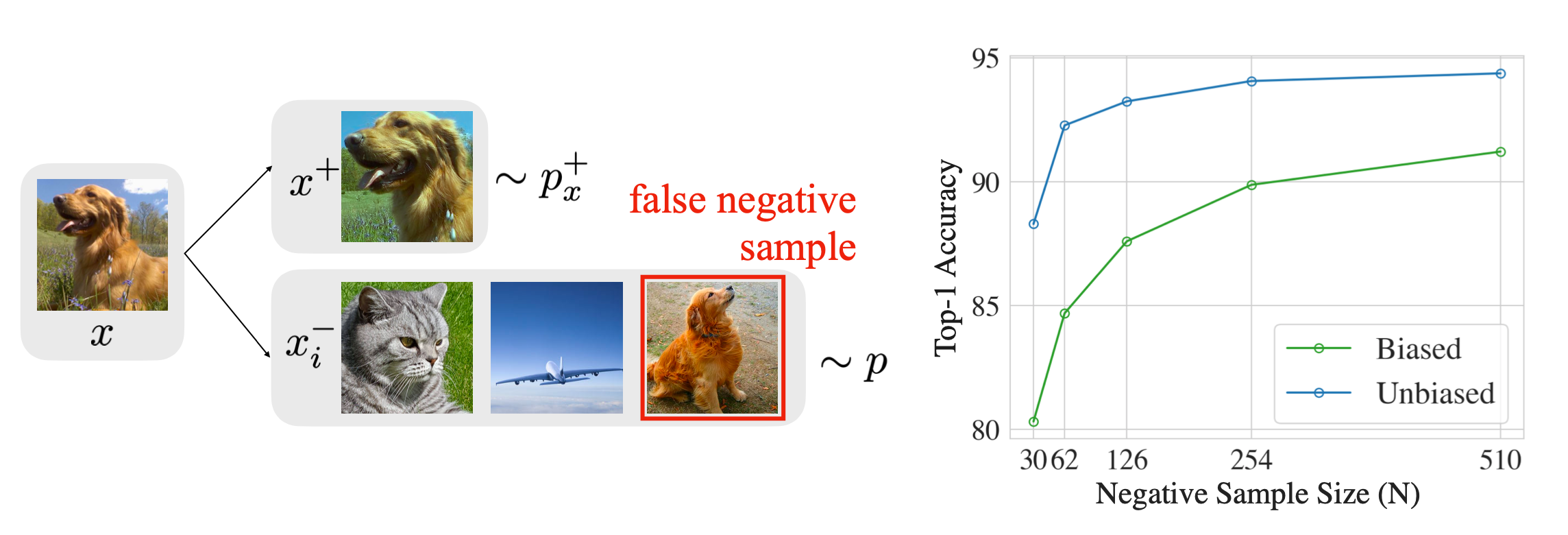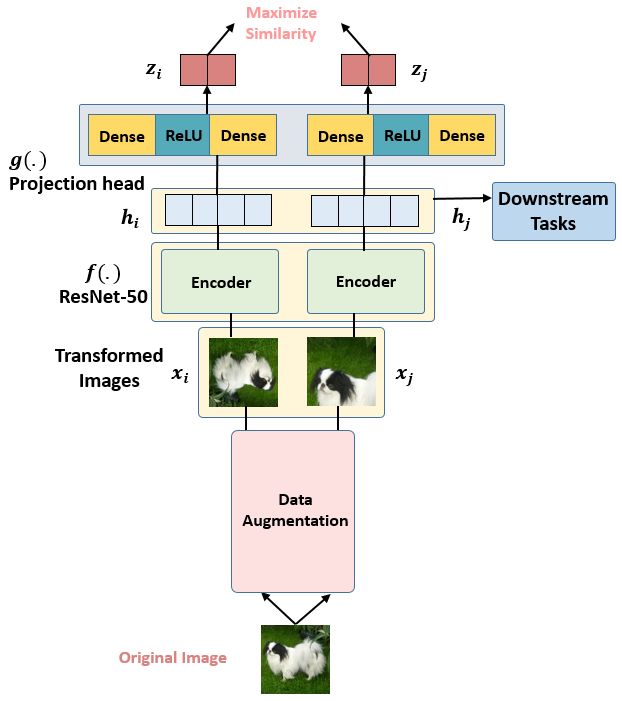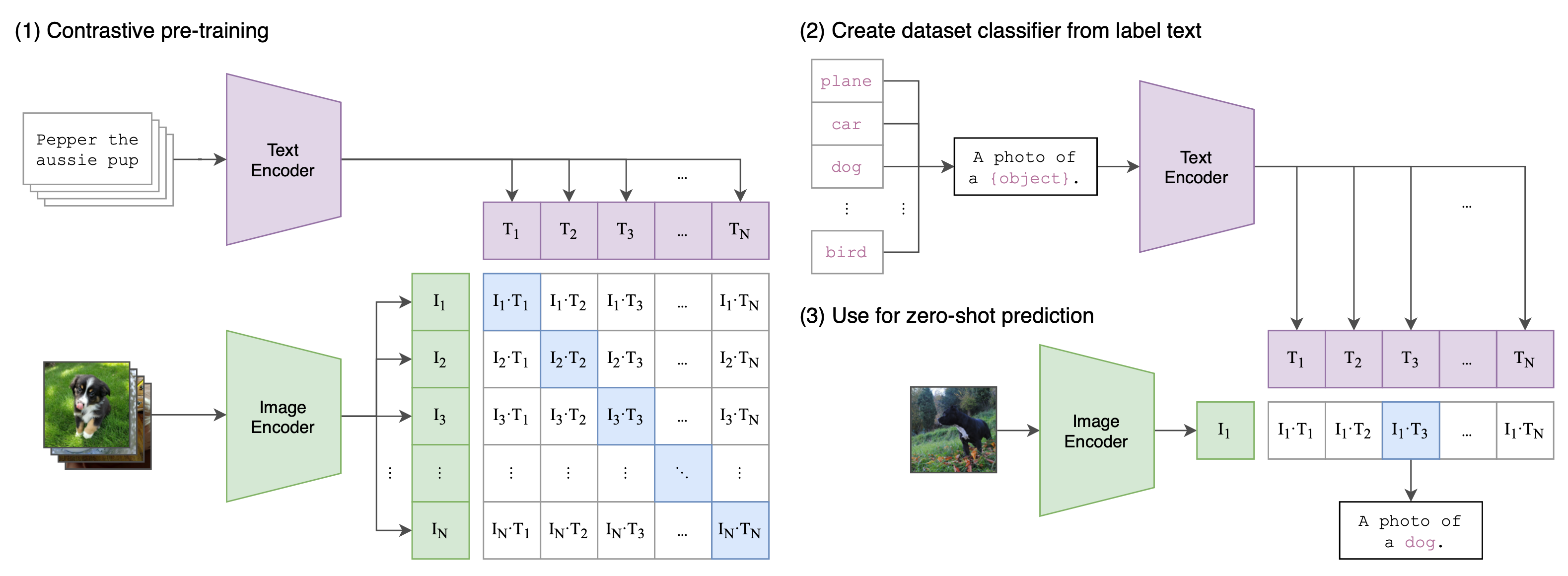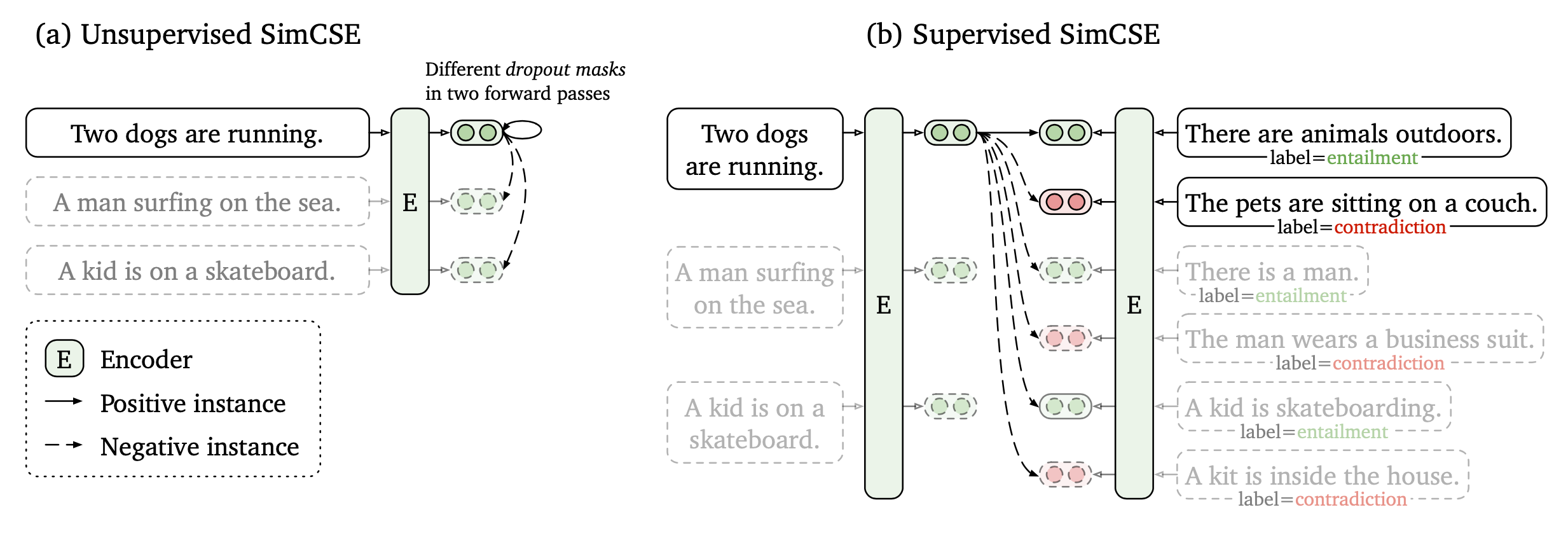目录
Self-Supervised Learning 的核心思想
Unsupervised Pre-train, Supervised Fine-tune.

两大主流方法
- 基于 Generative 的方法
- 基于 Contrative 的方法
基于 Generative 的方法主要关注的重建误差,还原原始输入;
基于Contrastive 的方法不要求模型能够重建原始输入,而是希望模型能够在特征空间上对不同的输入进行分辨,判断输入是否相似。

实践应用
- BERT系列:nlp
- VIT系列:cv
- data2vec系列:multimodal
- SimCLR系列:对比学习
- MoCo系列
Contrastive Representation Learning
对比学习指导原则
- 构造相似实例和不相似实例
- 习得一个表示学习模型,使得相似的实例在投影空间中比较接近,而不相似的实例在投影空间中距离比较远
对比学习目标函数
Contrastive Loss
最早的Loss是对比Loss,即同类样本间更相似,最小化同类样本的embedding 距离,最大化非同类embedding的距离
\[\mathcal{L}_\text{cont}(\mathbf{x}_i, \mathbf{x}_j, \theta) = \mathbb{1}[y_i=y_j] \| f_\theta(\mathbf{x}_i) - f_\theta(\mathbf{x}_j) \|^2_2 + \mathbb{1}[y_i\neq y_j]\max(0, \epsilon - \|f_\theta(\mathbf{x}_i) - f_\theta(\mathbf{x}_j)\|_2)^2 \]Triplet Loss
Triplet loss最小化anchor和正样本间的距离,最大化anchor和负样本间的距离
\[\mathcal{L}_\text{triplet}(\mathbf{x}, \mathbf{x}^+, \mathbf{x}^-) = \sum_{\mathbf{x} \in \mathcal{X}} \max\big( 0, \|f(\mathbf{x}) - f(\mathbf{x}^+)\|^2_2 - \|f(\mathbf{x}) - f(\mathbf{x}^-)\|^2_2 + \epsilon \big) \]关键:选择合适的负样本,提升模型性能

N-pair Loss
Multi-Class N-pair loss generalizes triplet loss to include comparison with multiple negative samples.
Given a \((N + 1)\) tuplet of training samples,\(\{ \mathbf{x}, \mathbf{x}^+, \mathbf{x}^-_1, \dots, \mathbf{x}^-_{N-1} \}\), including one positive and \(N-1\) negative ones, N-pair loss is defined as:
\[\begin{aligned} \mathcal{L}_\text{N-pair}(\mathbf{x}, \mathbf{x}^+, \{\mathbf{x}^-_i\}^{N-1}_{i=1}) &= \log\big(1 + \sum_{i=1}^{N-1} \exp(f(\mathbf{x})^\top f(\mathbf{x}^-_i) - f(\mathbf{x})^\top f(\mathbf{x}^+))\big) \\ &= -\log\frac{\exp(f(\mathbf{x})^\top f(\mathbf{x}^+))}{\exp(f(\mathbf{x})^\top f(\mathbf{x}^+)) + \sum_{i=1}^{N-1} \exp(f(\mathbf{x})^\top f(\mathbf{x}^-_i))} \end{aligned} \]当负样本数量为1时,等价于多分类softmax。
NCE
把多分类问题转化成二分类,判断正样本和负样本是否为同一类。
\[\begin{aligned} \mathcal{L}_\text{NCE} &= - \frac{1}{N} \sum_{i=1}^N \big[ \log \sigma (\ell_\theta(\mathbf{x}_i)) + \log (1 - \sigma (\ell_\theta(\tilde{\mathbf{x}}_i))) \big] \\ \text{ where }\sigma(\ell) &= \frac{1}{1 + \exp(-\ell)} = \frac{p_\theta}{p_\theta + q} \end{aligned} \]其中 target sample \(\sim P(\mathbf{x} \vert C=1; \theta) = p_\theta(\mathbf{x})\), noise sample \(\sim P(\tilde{\mathbf{x}} \vert C=0) = q(\tilde{\mathbf{x}})\).
InfoNCE
\[\mathcal{L}_q = - \log\dfrac{\exp(q k_+ / \tau)}{\sum_i \exp(q k_i / \tau)} \]假设我们忽略\(\tau\),那么infoNCE loss其实就是cross entropy loss。唯一的区别是,在cross entropy loss里,\(k\)
指代的是数据集里类别的数量,而在对比学习InfoNCE loss里,这个\(k\)指的是负样本的数量.
如果温度系数设的越大,logits分布变得越平滑,那么对比损失会对所有的负样本一视同仁,导致模型学习没有轻重。如果温度系数设的过小,则模型会越关注特别困难的负样本,但其实那些负样本很可能是潜在的正样本,这样会导致模型很难收敛或者泛化能力差.
对比学习损失(InfoNCE loss)与交叉熵损失的联系,以及温度系数的作用 - Youngshell的文章 - 知乎 https://zhuanlan.zhihu.com/p/506544456
对比学习关键点
数据增强
对原始数据增加噪音等数据增强,生成正样本。
如SimCLR表明,随机裁剪和随机颜色失真对视觉表示学习非常关键。
大的BatchSize
对依赖In-batchNegative的场景,大的batch size可以提高训练效率,增加模型挑战。
hard Negative Mining
对于有监督情况,可以直接将其它类样本作为负样本;
对于无监督情况,可能会偶然把同类样本作为负样本,导致性能大幅下降。

vision
Image Augmentation
裁剪、缩放、加噪、翻转、转换灰度图
常用框架:AutoAugment、RandAugment、PBA、UDA
图像混合
SimCLR


loss, 每个Batch里面的所有Pair的损失之和取平均:
\[L = \frac{1}{2N}\sum_{k=1}^{N}[l(2k-1,2k)+l(2k,2k-1)] \]
CLIP

nlp
Text Augmentation
编辑距离、随机替换、删除等
SimCSE
Unsupervised SimCSE
Supervised SimCSE


SimCSE2 中改进了两点:
- 负样本质量,原本都是同一句话的embedding dropout,但句子长度相同,会导致模型倾向。
- batchsize过大,引起性能下降,未解之谜
def unsup_loss(y_pred, lamda=0.05, device="cpu"):
idxs = torch.arange(0, y_pred.shape[0], device=device)
y_true = idxs + 1 - idxs % 2 * 2
similarities = F.cosine_similarity(y_pred.unsqueeze(1), y_pred.unsqueeze(0), dim=2)
similarities = similarities - torch.eye(y_pred.shape[0], device=device) * 1e12
similarities = similarities / lamda
loss = F.cross_entropy(similarities, y_true)
return torch.mean(loss)
def sup_loss(y_pred, lamda=0.05, device="cpu"):
row = torch.arange(0, y_pred.shape[0], 3, device=device)
col = torch.arange(y_pred.shape[0], device=device)
col = torch.where(col % 3 != 0)[0]
y_true = torch.arange(0, len(col), 2, device=device)
similarities = F.cosine_similarity(y_pred.unsqueeze(1), y_pred.unsqueeze(0), dim=2)
similarities = torch.index_select(similarities, 0, row)
similarities = torch.index_select(similarities, 1, col)
similarities = similarities / lamda
loss = F.cross_entropy(similarities, y_true)
return torch.mean(loss)
References
【1】对比学习(Contrastive Learning):研究进展精要. https://zhuanlan.zhihu.com/p/367290573
【2】https://lilianweng.github.io/posts/2021-05-31-contrastive/
【3】Self-Supervised Learning 超详细解读 (目录) - 科技猛兽的文章 - 知乎 https://zhuanlan.zhihu.com/p/381354026
【4】对比学习损失(InfoNCE loss)与交叉熵损失的联系,以及温度系数的作用 - Youngshell的文章 - 知乎 https://zhuanlan.zhihu.com/p/506544456
标签:loss,mathbf,similarities,样本,学习,简记,device,theta,对比 From: https://www.cnblogs.com/gongyanzh/p/17142270.html